
Visit Shrines
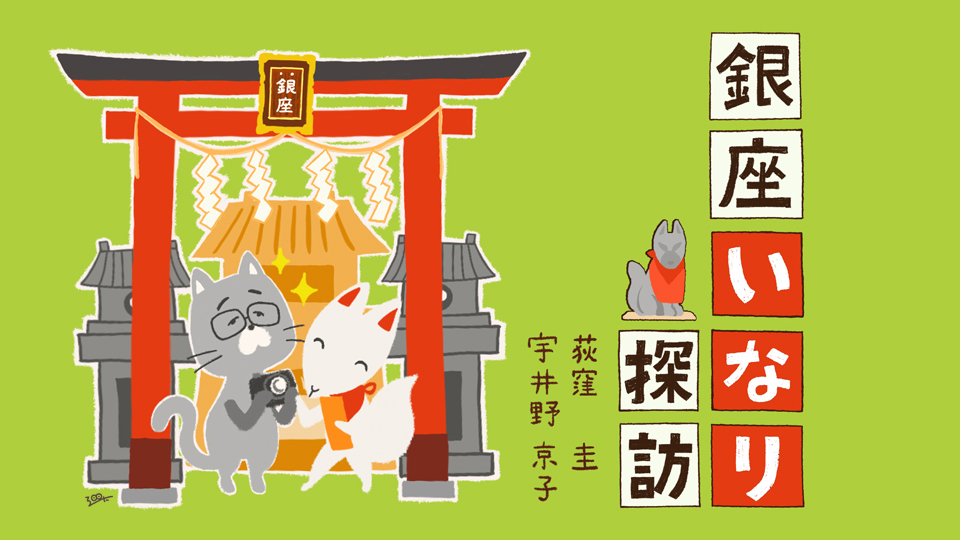
Visit Ginza’s Shrines Vol. 11 Komparu Inari
2022.08.01
People come from all over Japan to visit Ginza. Different “antenna shops,” or prefectural satellite shops, also feature various local specialties. This may be one of the reasons why we feel such diversity in this town. So, what special Inari shrine will we be visiting today?
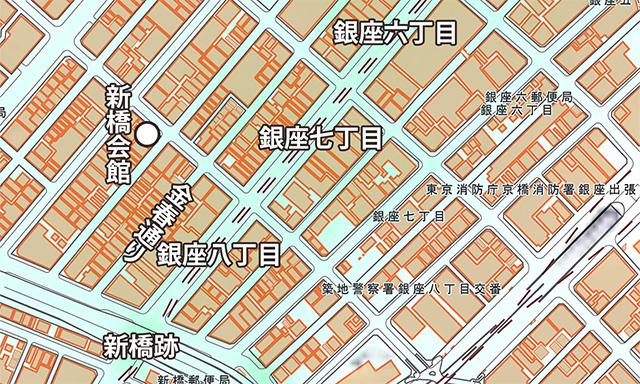
- Ogikubo
- This time we are visiting Ginza 8-chome, the southernmost area of Ginza. If we cross the street, we will find ourselves in Shimbashi.
- Uino
- The area is named after a bridge that really used to exist here.
- Ogikubo
- Yes, Shimbashi Bridge hung over Sanjukken-bori, which used to run right under the Shuto Expressway and was completely reclaimed. I had imagined the area would be more like Shimbashi, but it bears Ginza’s atmosphere.
- Uino
- Yes. This is Ginza with its bright neon lights, as we know it from novels and TV dramas.
- Ogikubo
- Where is the Inari shrine? There is no shrine in sight.
- Uino
- Actually, the Inari shrine that we are going to visit today sits on the rooftop of Shimbashi Kaikan, which houses the Tokyo Shimbashi Kumiai. It is closed to the public. It is called Komparu Inari.
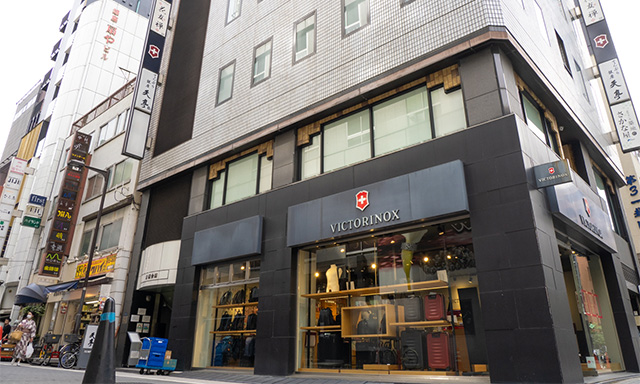
- Ogikubo
- If I remember correctly, there is a public bath called Komparu-yu. Isn’t Komparu the name of a Noh school?
- Uino
- Yes. It comes from the Noh Komparu-ryu (Komapru school). Komparu-ryu originated in the “Enmani-za,” which served Kofuku-ji Temple and Kasugataisha Shrine in Nara. Noh is a performing art with one of the longest histories in the world and Komparu-ryu is one of the older schools. An even now, they offer Noh performances at the Takigi Noh (bonfire Noh) at Kofuku-ji and the On-matsuri festival at the Kasuga Wakamiya Shrine.
- Ogikubo
- So the name bears a lot of history. What brought the Komparu name to Ginza?
- Uino
- Noh had been favored by Hideyoshi Toyotomi and in the Edo period it was allocated Chigyo-chi (territory) in the area which is Ginza today. Groups of Noh performers were hired directly by the Bakufu as state companies. Komparu was one of them and they were based in what is Ginza 8-chome today (then Sanno-cho).
- Ogikubo
- So that is why their name remains in Komparu-dori and Komaparu-yu. You wonder why when you are not familiar with the background. Then, let us check the map as we always do. First, I have the “Edo Kirie-zu” from the end of the Edo period.
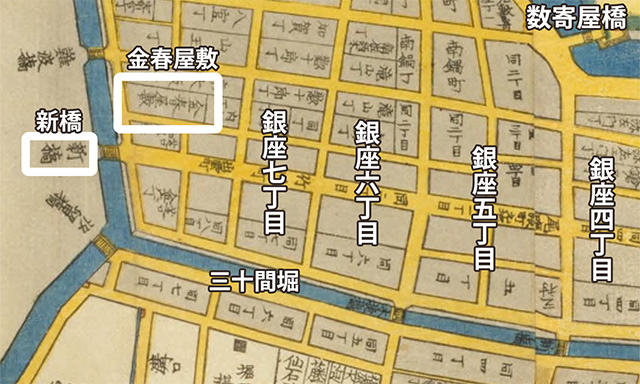
”Komparu Yashiki” is marked in the Ginza 8-chome area.
- Uino
- There it is. Is the street running between Komparu Yashiki and Chuo-dori, today’s Komparu-dori?
- Ogikubo
- That is right. Komparu-dori does not yet appear on the map in the early Edo period. Instead, it says “Shichiro Komparu.” This tell us that the area was the property of the Komparu family from the early Edo period. Ieyasu Tokugawa must have brought them to Edo from Kyoto in times when Noh was a popular pastime among samurai.
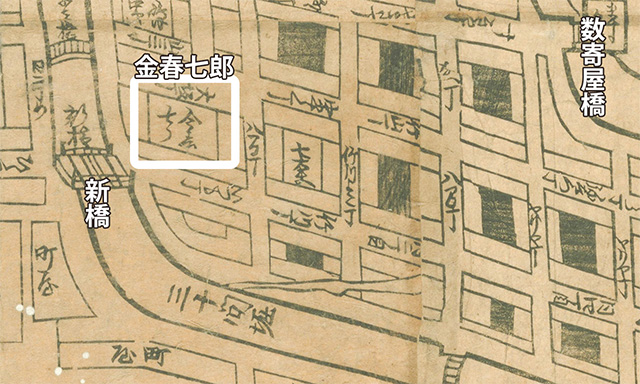
“Shichiro Komparu” is marked on the map.
(from the National Library Digital Collection)
- Uino
- Shall we go Komparu-dori?
- Ogikubo
- That is a good idea. I wonder if we can find anything from the Edo period. I recall seeing old bricks and an old wooden barrel in front of a store called Noble Pearl. It says the wooden barrel was a part of waterpipes during the Edo period. The bricks are from the early Meiji period.
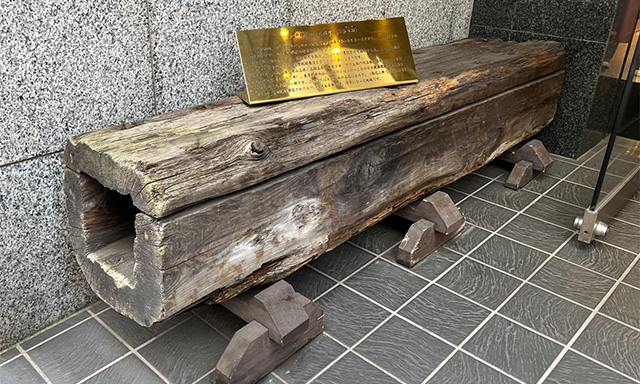
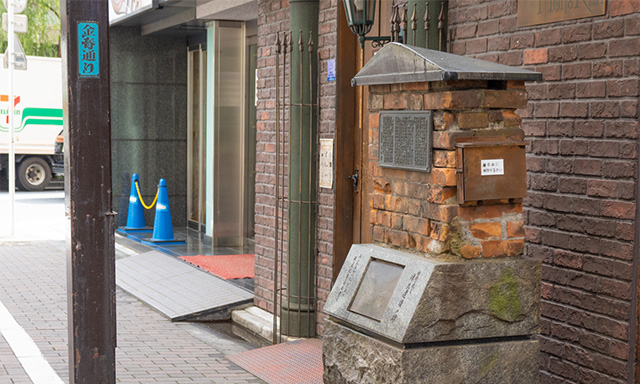
continue to sit on Komparu-dori.
- Uino
- It seems some of what was excavated during construction works in Ginza 8-chome were moved here. Some of the bricks can still be seen in the store, so let’s have a look. They have lived and run a business in Ginza since 1947 (Showa 22) and are actively engaged in local activities.
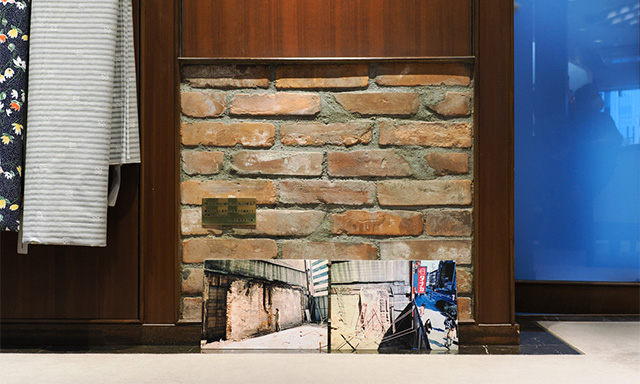
They chicly use the bricks from the Meiji period as a part of their interior decorations.
The photo panels in the front show the how the brick wall was unearthed.
We were told that the bricks came from the excavation.
- Ogikubo
- It is so nice that these bricks are locally preserved. I would have loved to see Ginza made with these bricks. So, what happened to Komparu Inari shrine?
- Uino
- There is more history to that story. After the Komparu family moved out in the late Edo period, in 1780, this area became an entertainment zone and the Geisha in the area came to be called “Komparu Geisha.” Then teahouses and Okiya lodging houses were built after the Komparu estate.
- Ogikubo
- This area is close to Shimbashi Station, Japan’s first railway station. Close to the railway and to the government offices, politicians must have gathered night after night. Back then it was not rare for famous politicians to get married with their favorite geisha.
- Uino
- A Kenban (geisha union) was also established. That is why the street behind Komparu-dori is called Kenban-dori. Shimbashi Kaikan, where the Shimbashi geisha rehearse stands on Kenban-dori.
- Ogikubo
- So, although we call them Shimbashi Geisha, they are based in Ginza 8-chome. And what is their relationship with Komparu Inari shrine? The shrine was the guardian god of the Komparu family estate and used to be located on Komparu-dori. However, it is no longer here.
- Uino
- It currently sits on the rooftop of Shimbashi Kaikan, which houses the rehearsal facilities of the Tokyo Shimbashi Kumiai.
- Ogikubo
- So, Noh, a traditional Japanese art from medieval times has gotten itself somehow connected with geisha?
- Uino
- I guess you could say that. Do you not find it fascinating that the family estate guardian of a Noh head family sits on the rooftop of the building housing the Kenban, or the geisha agency that manages and dispatches geisha, and where the geisha practice dancing and traditional Japanese music? The shrine is closed to the public but the geisha who come to the building for rehearsals pay their respect to it. And guess what?
- Ogikubo
- What?
- Uino
- This time we have special permission to take pictures for the “Visit Ginza’s Inari Shrines” article. Therefore, let us pay our respect before we take pictures.
- Ogikubo
- Thank you. Let us go. It is a small but picturesque shrine.
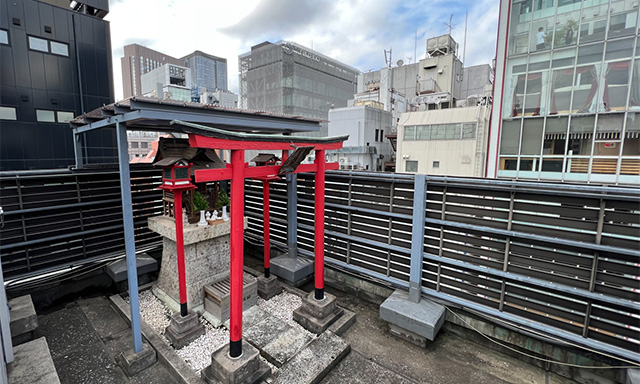
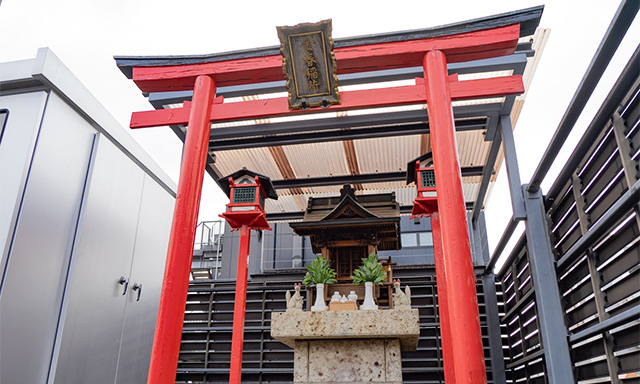
There were times when crows dropped stones into the offertory box.
- Ogikubo
- So the relationship between Ginza and Komparu-ryu only remains in the Inari shrine itself and its name?
- Uino
- Actually, the connection remains not only in the name. People who have long lived in this area, which was once a cultural mecca, are very passionate about keeping or restoring old images of the area. With this passion and the cooperation of Komparu Enmani-kai, the “Nohgaku Komparu Matsuri” festival is held on Komparu-dori every year. A special stage is set up for offeratory performances unique to the Komparu-ryu. During the festival, an Otabisho (temporary shrine) is installed in the store window of Noble Pearl and the deity of Komparu Inari Shrine sits there for a limited time. This allows people to offer prayers to a deity that they usually have no access to.
- Ogikubo
- That is a wonderful effort! We have very limited opportunities to see Noh performances so it would be great to visit Ginza for the festival.
- Uino
- Performing arts originated as offerings to the gods. What a strong message that the same shrine has been a guardian of performing arts, which have evolved with the times, from the Edo period up to now! I am sure that Komparu Inari Shrine will continue to guard those who are making great efforts every day to preserve culture and traditions.
All List
- 2020.05.01 Visit Ginza’s Inari Shrines Vol.2 Asahi Inari Shrine
- 2020.08.01 Vol.3 Exploring Ginza in the Edo Period on an old map
- 2020.11.01 Visit Ginza’s Inari Shrines Vol. 4 Kakugo Inari Shrine
- 2021.02.01 Visit Ginza’s Inari Shrines Vol. 5 Azuma Inari
- 2021.05.01 Visit Ginza’s Inari Shrines Vol.6 Kabuki Inari
- 2021.08.01 Visit Ginza’s Inari Shrines Vol.7 Ginza Inari in Ginza 2-chome
- 2021.11.01 Visiting Ginza’s Shrines Vol. 8 Kumagai Inari Shrine
- 2022.02.01 Visit Ginza Shrines Vol. 9 Saiwai Inari Shrine
- 2022.05.01 Visit Ginza’s Shrine Vol. 10 Mimeguri Shrine and Shusse Jizoson on the roof of Mitsukoshi Department Store
- 2022.08.01 Visit Ginza’s Shrines Vol. 11 Komparu Inari
- 2022.11.01 Visit Ginza’s Inari Shrines Vol.12 Mankin Ryujin Seiko Inari Shrine
- 2023.02.01 Visit Ginza’s Shrines Vol.13 Hachikan Shrine
- 2023.05.01 Visit Ginza’s Inari Shrines Vol.14 Hoju Inari Shrine
- 2023.08.01 Visit Ginza’ Inari Shrines Vol. 15 Ryuko Fudo-son
- 2023.11.01 Visit Ginza’s Shrines Vol. 16 Hodo Inari Shrine
- 2024.02.01 Visit Ginza’s Shrines Vol. 17 Toyoiwa Inari Shrine
- 2024.05.01 Visit Ginza’s Inari Shrines Vol. 18 Yasuhira Shrine
- 2024.08.01 Visit Ginza’s Inari Shrines: Final Edition








